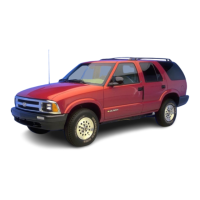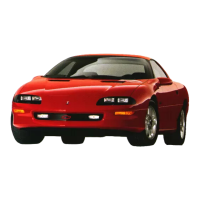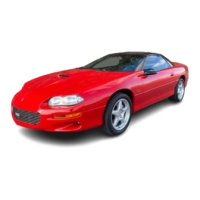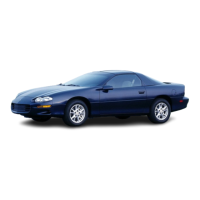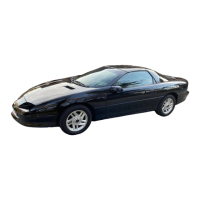Do you have a question about the Chevrolet 1996 Camaro and is the answer not in the manual?
Explains how to adjust seats, including reclining front seatbacks and folding rear seatbacks.
Details the adjustment of manual front seats, including fore/aft and height options.
Explains how to adjust seats using two levers for fore/aft and angle adjustments.
Describes the three controls for power seat adjustment: front, back, and overall position.
Provides guidance on adjusting head restraints for optimal neck protection in a crash.
Explains how to fold front seatbacks for access and ensures they are locked properly.
Details how to fold the rear seatback down to increase storage space in the vehicle.
Explains the importance and proper use of safety belts, including the SIR system.
Provides instructions for adults on wearing lap-shoulder belts correctly for maximum protection.
Explains the function and components of the air bag system, including driver and passenger airbags.
Details critical safety information about airbags, including proper seating and the danger of close proximity.
Explains the system's operation, including the readiness light and the location of driver and passenger airbags.
Describes when airbags inflate, what triggers them, and how they provide restraint in collisions.
Explains the function of ignition and door keys, and the importance of keeping keys safe.
Details the difference between ignition and door keys and the notice regarding extra keys for theft prevention.
Explains the dangers of unlocked doors and the importance of locking them for safety and security.
Describes how to use the power door lock switch for locking and unlocking doors simultaneously.
Covers options like Last Door Closed Locking, Lockout Prevention, and Remote Lock Control for vehicle security.
Details transmitter verification, matching procedures, and interference troubleshooting for remote lock systems.
Explains the operation of remote lock controls, including door unlock, hatch release, interior lamps, and alarm/panic modes.
Describes hatch release via key and the caution regarding carbon monoxide when the hatch is open.
Explains how to use the remote hatch release switch and notices regarding closing the hatch.
Provides tips on preventing vehicle theft, including key management and parking strategies.
Details the theft-deterrent alarm system, including the shock sensor and its adjustment capabilities.
Explains how to arm the system using the transmitter or power locks, and how to disarm it.
Outlines programmable features for locks and lighting systems, and the procedure to access customization mode.
Details settings for Exit Lighting, Delayed Illumination, Last Door Closed Locking, and Lockout Prevention.
Explains how the system confirms commands via parking lamps and horn chirps, and how to change settings.
Describes different methods for arming the theft-deterrent system and how to verify if it is armed.
Covers the driver's door alarm delay feature and the shock sensor's enable/disable function.
Provides guidelines for the initial break-in period and explains the different ignition switch positions.
Details ignition positions (OFF, RUN, START) and the key release mechanism for manual transmissions.
Explains the procedures for starting the engine with automatic and manual transmissions, including safety features.
Provides specific instructions for starting the 3.8 liter engine, including notices about key usage and electrical equipment.
Offers specific guidance for starting the 5.7 liter engine, including cold weather procedures and notices.
Explains the use of the engine coolant heater for easier starting and better fuel economy in cold weather.
Details the different positions of the shift lever and the safety caution for parking.
Explains shifting procedures for PARK, REVERSE, and NEUTRAL, with cautions on racing engines.
Describes the use of AUTOMATIC OVERDRIVE, DRIVE, and SECOND gears, including notices about transmission damage.
Explains the shift pattern and operation for the 5-speed manual transmission, including shifting into first gear.
Details the shift pattern and operation for the 6-speed manual transmission, including shifting into reverse.
Explains the function of the skip shift light and the recommended shift speeds when it is active.
Provides a chart of recommended shift speeds for manual transmissions to ensure proper fuel economy and performance.
Covers the Second-Gear Start feature for traction and the operation of the parking brake.
Provides a step-by-step guide for safely shifting into PARK for automatic transmission models.
Offers cautions and procedures for leaving the vehicle with the engine running, including torque lock prevention.
Explains how to shift out of PARK, especially when the shift lever may be stuck, and includes a caution about parking on flammable materials.
Discusses the dangers of engine exhaust (CO) and cautions for running the engine while parked.
Covers manual and power window operation, horn usage, and door lock warnings.
Explains the tilt steering wheel adjustment and the functions of the multifunction lever for signals and lights.
Details how to operate turn signals and change headlamp beams, including troubleshooting for signal bulbs.
Explains how to operate windshield wipers, adjust speed, and care for wiper blades.
Covers windshield washer operation, including freezing weather caution, and the basics of cruise control.
Provides instructions on setting cruise control, including safety cautions and when not to use it.
Explains how to increase or decrease speed while using cruise control and how to resume a set speed.
Discusses cruise control performance on hills and methods for ending cruise control, including speed memory.
Explains the main lamp control knob for headlamps, taillamps, and instrument panel lights, plus headlamp reminders.
Describes the function of Daytime Running Lamps (DRL) and Fog Lamps, including operational conditions.
Covers instrument panel brightness control and courtesy lamp operation linked to the main switch.
Explains courtesy lamps, delayed illumination, and exit lighting features, and how to turn them on/off.
Details the map lamps in the rearview mirror and the RAP feature for power accessories after ignition off.
Covers the inside day/night rearview mirror and outside manual and remote control mirrors.
Explains power mirror adjustments and the characteristics and cautions for convex outside mirrors.
Describes the glove box, front console storage for tapes and CDs, and cupholder location.
Explains how to remove and install the close-out panel for hidden storage in the rear area.
Covers the ashtray, lighter operation, and cautions regarding improperly stored close-out panels.
Details sun visor usage and the accessory plug for connecting electrical equipment, including load limits.
Advises on proper floor mat placement and cautions for removing/installing T-top roof panels.
Provides instructions for installing T-top sunshades, including alignment and proper storage cautions.
Explains how to lower the convertible top and provides notices regarding sun/rain damage and cold weather operation.
Details the steps for installing the boot cover after lowering the convertible top, including storage of cover pieces.
Provides procedures for raising the convertible top, including lowering visors/windows and removing the boot cover.
Introduces the instrument cluster and its role in displaying vehicle running information.
Lists and labels various components of the instrument panel, such as deflector, lights, cluster, and controls.
Explains that the instrument cluster provides at-a-glance information on speed, RPM, fuel, and other vital indicators.
Describes the speedometer, odometer, trip odometer, tachometer, and warning lights/gages.
Explains the function of warning lights and the safety belt reminder light and tone.
Details the air bag readiness light and the voltmeter, explaining their readings and potential issues.
Explains the brake system warning light, its function, and what to do if it illuminates.
Describes the ABS warning light, its normal operation, and what flashing or steady illumination signifies.
Explains the ASR warning light, its function, and conditions that may cause it to activate.
Describes the Low Traction light and the Engine Coolant Temperature gauge, indicating overheating.
Explains the low coolant light, its function, and what to do if it indicates low coolant levels.
Details the service engine soon light, its purpose for emission control systems, and what steady or flashing lights mean.
Explains actions to take if the malfunction light is flashing or stays on steady, including checking fuel cap and potential electrical issues.
Describes the engine oil pressure gage, normal operating ranges, and what red area readings indicate.
Explains the low oil light and the function of the oil level monitoring system, including its limitations.
Details the check gages light and common owner concerns regarding the fuel gage's normal operation.
Introduces the comfort control system for heating, ventilation, and air conditioning, including fan and temperature controls.
Explains the air control knob settings (VENT, BI-LEVEL, HEATER, BLEND, DEFROST) and MAX/A/C options for cooling.
Guides on operating the cooling system (MAX, A/C) and heating system (HEATER, BI-LEVEL) for comfort.
Explains the ventilation system, tips for visibility, and procedures for defogging and defrosting windows.
Details the operation of the rear window defogger, including indicator light and automatic shut-off.
Provides instructions for setting the clock on different Delco audio systems with cassette or CD players.
Explains how to find stations, play the radio, and use volume/seek functions on the cassette player.
Covers pushbutton memory, tone settings, speaker balance/fade, and cassette tape playback functions.
Covers tone settings, speaker adjustments, and proper handling and playback of compact discs.
Guides on CD player operation, troubleshooting disc playback errors, and stopping/ejecting discs.
Explains how to play cassette tapes, use player functions like REVERSE/FORWARD, and the APS feature.
Details operating the Delco-Bose system, finding stations, playing the radio, and setting presets.
Covers tone settings, speaker adjustments, and proper handling and playback of compact discs.
Explains the Delco-Loc II security feature for the CD player and how to activate/deactivate it.
Provides detailed steps for entering secret codes to activate and unlock the theft-deterrent feature after power loss.
Explains how to disable the theft-deterrent feature and provides tips on understanding FM/AM radio reception.
Offers advice on avoiding hearing loss, adding sound equipment, and caring for cassette tape players.
Provides guidance on handling compact discs and maintaining the fixed mast antenna.
Emphasizes the importance of defensive driving, preparedness, and maintaining adequate following distance.
Highlights the severe risks of driving under the influence of alcohol, affecting judgment, coordination, and vision.
Explains the three systems controlling a vehicle (brakes, steering, accelerator) and the factors affecting braking distance.
Describes the ABS system, its self-check process, and the meaning of the ABS warning light.
Explains the Low Traction light and the ASR system's function in limiting wheel spin, including normal operation.
Details how the ASR system automatically engages, how to turn it off, and conditions that may cause its warning light.
Discusses effective steering in emergencies and the implications of losing power steering assist.
Provides guidance on performing evasive steering maneuvers to avoid collisions when braking is insufficient.
Explains how to recover the vehicle if its wheels drop off the road edge onto the shoulder.
Offers essential tips for safely passing other vehicles on two-lane roads, emphasizing visibility and distance.
Explains the causes of vehicle skids (braking, steering, acceleration) and how to handle them.
Highlights the increased risks of night driving and the importance of visibility and alertness.
Provides tips for improving night vision and managing glare from oncoming headlights.
Discusses the challenges of driving in wet conditions, including reduced traction and the importance of clear visibility.
Explains the risks associated with wet brakes and cautions against driving through deep water.
Details the phenomenon of hydroplaning, its causes, and provides additional tips for driving safely in rain.
Offers advice for increasing safety in city driving, including route planning and traffic signal awareness.
Outlines essential rules and techniques for safe freeway driving, including merging and lane usage.
Provides a checklist of items to inspect before embarking on a long trip to ensure vehicle readiness and safety.
Discusses highway hypnosis and offers tips for safer and more enjoyable driving on hills and mountain roads.
Provides essential advice for winter driving, including vehicle preparation and emergency supplies.
Details how to drive safely on slippery surfaces like snow and ice, including the role of ASR.
Offers guidance on what to do if caught in a blizzard, including summoning help and staying warm.
Explains how to load the vehicle properly and identifies key weight information labels for capacity and safety.
Details GVWR, GAWR, and cautions about proper cargo loading to maintain vehicle control and safety.
Covers essential equipment and safety rules for towing trailers, including hitch types and brake requirements.
Offers important points for deciding to tow a trailer, including legal restrictions and break-in procedures.
Discusses important factors related to trailer weight, including limits and dealer resources for information.
Explains the importance of trailer tongue weight and total weight on vehicle tires, including inflation pressure.
Covers hitch installation rules, safety chain attachment, and trailer brake requirements for safe towing.
Provides essential techniques for driving, passing, and backing up while towing a trailer.
Advises on turn signals when towing and making wider turns to avoid trailer contact with the vehicle.
Offers guidance for driving on downgrades and uphills, and procedures for parking on hills with a trailer.
Details steps for leaving a vehicle parked on a hill and the increased maintenance needs when trailer towing.
Explains how to use hazard warning flashers to alert others and signal a vehicle problem.
Discusses the use of reflective triangles and provides safety steps for jump-starting a dead battery.
Details the steps for jump-starting, including vehicle compatibility checks and cautions about electrical systems.
Provides critical safety warnings about battery acid, explosive gas, and electrical hazards.
Explains the correct procedure for connecting jumper cables to batteries and vehicles, with cautions about moving parts.
Advises on proper towing procedures, including information to provide to towing services and vehicle modifications.
Lists critical safety precautions to help avoid injury to yourself and others during towing operations.
Details how to secure a vehicle for transport and outlines restrictions for towing on drive wheels.
Explains how to attach T-hook chains for front towing and provides notices regarding equipment usage.
Covers rear towing methods, including the use of specific equipment and cautions to avoid damage.
Explains how to identify engine overheating and the severe burn hazard from steam.
Provides steps to take if the overheat warning light is on but no steam is visible, and how to proceed if the warning persists.
Identifies key components visible under the hood (V6 Engine) and warns about the electric fan hazard.
Guides on checking coolant levels and identifying potential leaks in the cooling system, with cautions about hot parts.
Explains how to add coolant to the recovery tank and the dangers of using plain water or improper mixes.
Provides specific instructions for adding coolant to the radiator for V6 engines, including pressure cap removal.
Offers specific instructions for adding coolant to the radiator for V8 engines, with a notice regarding the LT1 engine's procedure.
Explains what to do if a tire goes flat and provides steps for safely changing a tire, including vehicle securing.
Details how to remove the close-out panel and access the spare tire and necessary tools from the rear area.
Explains the use of the jack and wheel wrench for lifting the vehicle and attaching the wrench to the jack bolt.
Guides on removing center caps or bolt-on wheel covers and mentions tire cleaning with a brush.
Provides step-by-step instructions for removing the flat tire and installing the spare tire, including jack positioning.
Emphasizes safety precautions when jacking a vehicle and the importance of proper jack positioning to prevent damage or collapse.
Explains how to remove rust/dirt from wheel bolts and the process of replacing wheel nuts after tire removal.
Warns about the dangers of loose wheel nuts due to rust/dirt and the importance of proper tightening and using correct nuts.
Details how to lower the vehicle after tire change and the importance of properly tightening wheel nuts with a torque wrench.
Provides guidance on storing the spare tire and tools safely and notes that wheel covers do not fit compact spares.
Explains how to reassemble the tire changing equipment and replace the flat tire using storage instructions.
Provides information on compact spare tire inflation, performance limits, and cautions regarding car washes and speed.
Offers advice on what to do when stuck, emphasizing caution when spinning wheels and avoiding excessive speed.
Explains the "rocking" technique to free a stuck vehicle and advises on turning off the ASR system if applicable.
Encourages using Chevrolet dealers for service and highlights the benefits of genuine GM parts and trained technicians.
Warns about the dangers of DIY service without proper knowledge, tools, or parts, and advises keeping service records.
Details recommended fuel types, octane ratings, and explains the impact of fuel quality on performance and emissions.
Provides advice on fuel availability abroad and cautions against using fuels containing methanol.
Explains how to open the fuel filler door, remove the cap, and safely add fuel, with cautions about gasoline vapor.
Guides on checking engine oil and other fluids, with safety cautions regarding electric fans and hot engine parts.
Details how to open the vehicle hood by releasing the handle inside and the front latch.
Identifies key components located in the engine compartment for the 3800 L36 engine.
Identifies key components located in the engine compartment for the 5.7L LT1 engine.
Explains how to check the engine oil level using the dipstick and the function of the low oil light.
Provides instructions on how to pull, clean, and read the engine oil dipstick for both 5.7L LT1 and 3800 L36 engines.
Advises on selecting the correct engine oil type using the API Starburst symbol and cautions against adding too much oil.
Details the recommended SAE viscosity grades for engine oil for the 5.7L LT1 engine based on temperature.
Provides recommended SAE viscosity grades for engine oil for the 3800 L36 engine based on temperature.
Explains when to change engine oil and filter, and proper procedures for used oil disposal to protect the environment.
Shows the location of the air cleaner for different engine types and advises referring to the maintenance schedule for replacement.
Guides on removing the air filter by releasing plastic pins and cautions against operating the engine without it.
Explains when to check and change automatic transmission fluid and filter, detailing conditions requiring more frequent service.
Details procedures for checking transmission fluid hot and cold, emphasizing proper temperature and cautions against overfilling.
Outlines steps for checking fluid levels hot or cold, including shifting through gears and running the engine at idle.
Shows how to read the transmission fluid dipstick for both 5.7L LT1 and 3800 L36 engines after wiping and reinserting.
Guides on adding transmission fluid, recommending DEXRON-III, and cautions against overfilling and using improper fluids.
Explains how to check and add fluid for manual transmissions, noting it does not require regular changing.
Covers checking hydraulic clutch fluid and rear axle lubricant levels, and when to check and change them.
Recommends lubricants for differentials and explains the use and properties of DEX-COOL engine coolant.
Details the proper coolant mixture (50/50 water/DEX-COOL) and cautions against using plain water or improper additives.
Guides on checking coolant levels in the recovery tank and radiator, and adding coolant when the engine is cool.
Explains the function of the radiator pressure cap and cautions against removing it when the system is hot due to steam and pressure.
Discusses the thermostat's role in coolant temperature control and when to check power steering fluid levels.
Guides on checking power steering fluid and selecting the correct windshield washer fluid, especially for freezing conditions.
Provides instructions for adding washer fluid, including cautions about mixing fluids and filling levels in cold weather.
Explains the brake fluid reservoir, reasons for fluid level changes, and cautions against topping off fluid or spilling it.
Guides on checking brake fluid level and using the correct DOT-3 fluid, with cautions about using the wrong type.
Describes brake pad wear indicators and cautions about the damage caused by spilling brake fluid on painted surfaces.
Discusses brake squeal, rear drum brake inspection, and the importance of replacing brake parts with genuine GM components.
Covers battery types, vehicle storage, and precautions for handling and replacing halogen bulbs.
Details the steps for removing and replacing headlamps, including handling the aiming ring and wiring connectors.
Explains how to prepare the vehicle for headlamp aiming and the function of horizontal and vertical aim indicators.
Provides steps for adjusting headlamp aim using aiming screws, with recommendations for optimal alignment and state inspection limits.
Guides on replacing bulbs for the front turn signal and the center high-mounted stoplamp.
Details the procedure for changing rear bulbs, which involves removing the entire housing, sockets, and bulbs.
Explains how to replace the bulb in the rear sidemarker assembly, including removing the screw and socket.
Provides instructions for removing and replacing the wiper blade assembly and the wiper blade element.
Discusses tire wear indicators, conditions requiring new tires, and cautions about tire maintenance and overloading.
Explains tire inflation pressures, how to check them, and the consequences of under- or over-inflation.
Guides on inspecting tires for wear, performing tire rotation, and using a gauge to check tire pressure.
Illustrates tire rotation patterns for specific tires and warns about wheel nut security due to rust or dirt.
Helps determine when new tires are needed and explains the importance of matching TPC Spec numbers for optimal vehicle performance.
Explains the UTQG system for grading tires on treadwear, traction, and temperature, and cautions against mixing tire types.
Details tire traction and temperature grades, and explains the importance of wheel alignment and balance for tire life.
Advises on replacing bent or damaged wheels and using only genuine GM parts for wheels, bolts, and nuts due to safety implications.
Warns against using used replacement wheels and cautions about tire chain compatibility and usage on specific tires.
Provides general advice on cleaning the vehicle's exterior and interior, including tips for stain removal and using cleaners safely.
Details how to clean fabric upholstery using foam-type or solvent-type cleaners and explains the benefits of Scotchgard fabric protector.
Offers solutions for specific cleaning issues like greasy/oily stains, non-greasy stains, and combination stains on vehicle fabrics.
Provides instructions for cleaning leather surfaces and the top of the instrument panel, with cautions about abrasive cleaners.
Covers cleaning the windshield, wiper blades, and weatherstrips, recommending specific products and procedures.
Advises on proper washing techniques to preserve the paint finish and offers tips for finish care, including polishing and protecting against damage.
Provides guidance on cleaning convertible tops and aluminum wheels, with cautions about car washes and cleaning agents.
Discusses repairing sheet metal damage, finish damage, and the importance of underbody maintenance to prevent corrosion.
Lists appearance care materials with part numbers, sizes, descriptions, and usage recommendations.
Explains the importance of the VIN and the Service Parts Identification Label for ordering parts and identifying vehicle specifications.
Discusses the electrical system, circuit protection for headlamps, wipers, and power options, and cautions about add-on electrical equipment.
Explains how fuses and circuit breakers protect the vehicle's wiring and how to replace a blown fuse.
Provides a chart detailing the usage of various fuses located in the fuse panel, aiding in troubleshooting electrical issues.
Identifies the location of underhood fuses and lists their corresponding usages for various vehicle systems.
Provides a comprehensive list of replacement bulbs for various vehicle locations, including page references for replacement procedures.
Lists engine types, displacements, and approximate capacities for various vehicle fluids and systems.
Provides vehicle dimensions and approximate capacities for the fuel tank, manual transmission, and rear axle lubricant.
Lists common replacement parts and provides information on air conditioning refrigerants, stressing the importance of using the correct type.
Explains the importance of proper vehicle maintenance for safety, dependability, and the environment.
Outlines the five parts of the maintenance section and provides precautions for performing DIY service.
Guides owners on how to select the correct maintenance schedule based on driving habits and conditions.
Details the definition and intervals for short trip/city driving maintenance services, including engine oil and tire rotation.
Outlines the definition and intervals for long trip/highway driving maintenance, including engine oil and automatic transmission service.
Lists maintenance services required at 3,000, 6,000, and 9,000 miles for short trip/city driving.
Details maintenance for short trip/city driving at 12,000 and 15,000 miles, including air cleaner filter inspection.
Lists maintenance for short trip/city driving at 18,000 and 30,000 miles, including automatic transmission fluid change under severe conditions.
Details maintenance for short trip/city driving at 33,000 and 36,000 miles, including steering linkage lubrication and tire rotation.
Lists maintenance for short trip/city driving at 39,000 and 42,000 miles, including steering linkage lubrication and tire rotation.
Details maintenance for short trip/city driving at 45,000 and 50,000 miles, including transmission fluid change and air cleaner filter inspection.
Lists maintenance for short trip/city driving at 54,000 and 60,000 miles, including steering linkage lubrication and tire rotation.
Details maintenance for short trip/city driving at 63,000 and 66,000 miles, including steering linkage lubrication and tire rotation.
Lists maintenance for short trip/city driving at 69,000 and 72,000 miles, including steering linkage lubrication and rear axle lubricant change.
Details maintenance for short trip/city driving at 75,000 and 80,000 miles, including transmission fluid change and air cleaner filter inspection.
Lists maintenance for short trip/city driving at 84,000 and 87,000 miles, including steering linkage lubrication and rear axle lubricant change.
Details maintenance for short trip/city driving at 90,000 and 95,000 miles, including steering linkage lubrication and transmission fluid change.
Lists maintenance for short trip/city driving at 96,000 and 100,000 miles, including coolant system service and spark plug replacement.
Details maintenance for short trip/city driving at 100,000 miles, including coolant system service and spark plug replacement.
Lists maintenance services for long trip/highway driving at 7,500 miles, including oil change and tire rotation.
Details maintenance for long trip/highway driving at 15,000 miles, including transmission fluid change under severe conditions.
Lists maintenance for long trip/highway driving at 22,500 and 30,000 miles, including steering linkage lubrication and transmission fluid change.
Details maintenance for long trip/highway driving at 37,500 miles, including steering linkage lubrication and tire inspection.
Lists maintenance for long trip/highway driving at 45,000 miles, including transmission fluid change under severe conditions.
Details maintenance for long trip/highway driving at 52,500 and 60,000 miles, including steering linkage lubrication and transmission fluid change.
Continues the 60,000-mile maintenance for long trip/highway, including inspection of drive belt and fuel system.
Lists maintenance for long trip/highway driving at 75,000 and 82,500 miles, including steering linkage lubrication and tire rotation.
Details maintenance for long trip/highway driving at 90,000 miles, including steering linkage lubrication and transmission fluid change under severe conditions.
Lists maintenance for long trip/highway driving at 97,500 miles, including steering linkage lubrication and tire inspection.
Details maintenance for long trip/highway driving at 100,000 miles, including coolant system service and spark plug replacement.
Outlines owner checks to be performed at fuel fill and monthly, covering fluid levels and tire pressure.
Covers checks for restraint systems, transmissions, clutch system, key locks, and body lubrication, performed semi-annually or annually.
Explains how to check the starter switch and the Brake-Transmission Shift Interlock (BTSI) for automatic transmissions.
Details checks for the steering column lock mechanism and the parking brake's holding ability, plus underbody flushing.
Lists periodic inspections for suspension, steering, exhaust, radiator/hoses, throttle linkage, rear axle, and brake systems.
Lists recommended fluids and lubricants by usage, including part numbers or specifications from GM dealers.
Provides a section to record scheduled service dates, odometer readings, and who performed the work.
Outlines the steps for addressing concerns with the dealership and escalating issues if necessary.
Provides contact numbers for the Chevrolet Customer Assistance Center in the US and Canada, and international locations.
Advises on information to have ready for customer assistance and provides contact details for Text Telephone (TTY) users.
Details the Roadside Assistance program, including Basic Care and Courtesy Care services, and the toll-free number.
Lists specific services covered by Roadside Assistance and Courtesy Transportation, noting eligibility and program details.
Explains GM's participation in the BBB AUTO LINE program for alternative dispute resolution regarding vehicle repairs.
Guides on reporting vehicle safety defects to NHTSA (US) and Transport Canada, and contact information for reporting.
Details how to report safety defects to Canadian authorities and General Motors, and where to purchase service manuals.
Explains the types of service literature available, including manuals, bulletins, and owner publications, and how to order them.
Directs to page 2-60 for information on the accessory plug and its usage.
Lists air bag related topics like system components, restraint, readiness light, servicing, and inflation.
Covers anti-lock brake system warnings, ASR system, audio systems, automatic transmission, and door locks.
Lists engine types, fuel information, engine oil, exhaust, exit lighting, and fuses and circuit breakers.
Covers instrument panel gauges, headlamp aiming, and ignition switch positions.
Lists topics related to vehicle labels, various warning lights, and locking mechanisms.
Covers methanol cautions, mirror types, and the multifunction lever controls.
Lists topics related to rear axle, seat restraints, safety belts, and their usage.
Covers seat types, service information, shift lever operation, and vehicle security features.
Explains the causes of vehicle skids (braking, steering, acceleration) and how to handle them.
Covers vehicle control, dimensions, loading, wheel alignment, and replacement.
| Brand | Chevrolet |
|---|---|
| Model | 1996 Camaro |
| Category | Automobile |
| Language | English |




